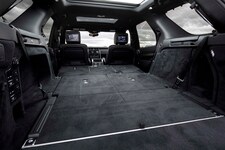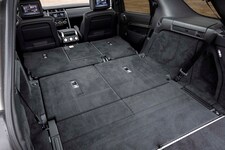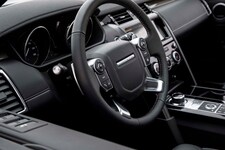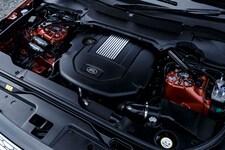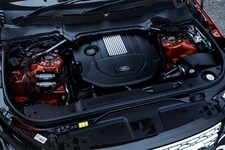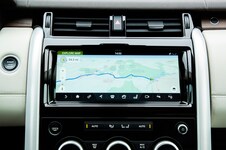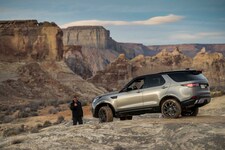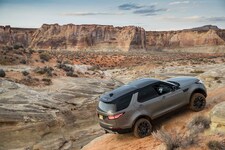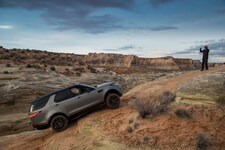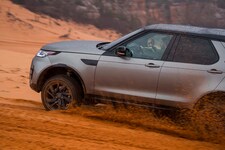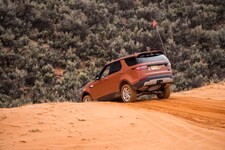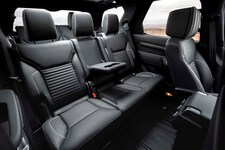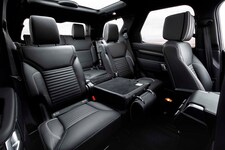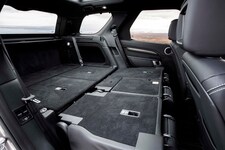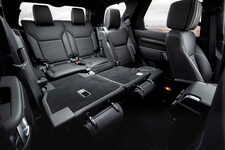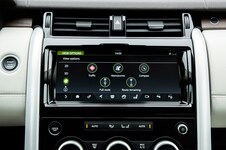Land Rover builds go-anywhere beasts that can traverse great distances in luxuriant opulence. Most people never need this extreme capability, but it’s good to know it can handle heavy sport when called upon.
Showing an ability to persevere through snow, sleet, hail, and rain while battling high winds and steep sand dunes, our redesigned 2017 Discovery snaked through southern Utah canyons and Arizona desert on our media drive. And although Land Rover had plotted this course to highlight the Disco’s strengths, its PR minders had no idea Mother Nature would supply such a meteorological onslaught. Seriously, the Postal Service would have stayed home.
But the Disco danced its way through the test. No winches, sand ladders, or other assists proved necessary during a two-day drive of almost 500 miles on- and off-road.
This is the second kick at this particular can for Motor Trend. We were able to test a prototype off-road a few months ago in Scotland on a greasy, muddy track through an estate in the highlands. But we were not allowed to take it on public roads.
We can now verify the successor to the LR4 handles like a gentleman on pavement but also retains its adventurous pluck under adverse conditions.
We started the day in rain, which quickly turned to blinding snow as we gained altitude near Zion National Park. Whiteout conditions descended upon our convoy as we passed a jackknifed tractor-trailer. (Our Land Rover Defender support vehicle straightened it out.)
Still, it was an omen of challenges to come.
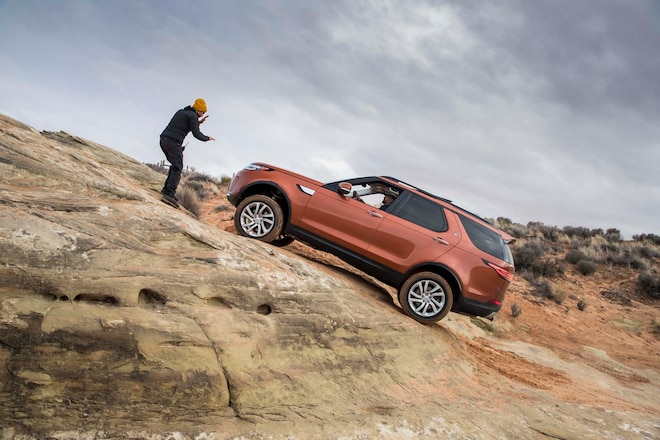
The Discovery dates back to 1989, when it was known for its boxy shape, stepped roof, and asymmetrical liftgate with a spare tire. The U.S. model changed its name to LR3 in 2004 (third-gen), followed by the current LR4.
This fifth-generation seven-passenger crossover reclaims the Discovery name while showing how far the vehicle has evolved. Its underpinnings have morphed from trucky body-on-frame construction to the more civilized monocoque form, with an aluminum body and steel subframe—sharing a platform with the Range Rover and Range Rover Sport. For those purists who say a real SUV must be body-on-frame, I provide Exhibit A that unibody works just fine for pretty much anything this side of global apocalypse.
To enter the modern age with this new platform, the design team penned a radical departure from the outgoing blocky LR4. This one has curves. The stepped roof is subtle, as is the asymmetrical rear deck that houses the license plate—but this Landie retains its signature clamshell hood.
Designer Massimo Frascella thinks the change will attract new buyers. The Range Rover lineup is designed to be more luxurious and sophisticated while Land Rover–badged vehicles focus on capability. The new Discovery is the most refined version of the rock crawler to date, both in road manners and in amenities such as heated power seats and USB outlets.
There are three engine choices globally; the U.S. gets the choice of a 3.0-liter supercharged V-6 gas engine (340 horsepower, 332 lb-ft of torque) or a quiet 3.0-liter turbodiesel V-6 (254 hp, 443 lb-ft of torque), mated to an eight-speed automatic.
Our preference is the gas engine. The diesel lacked power at highway speeds for passing—mashing the pedal produced few results, not surprising given that peak torque is available from 1,750 to 2,250 rpm. We had no such issues with the gasoline engine, which provided plenty of power and thrust. Those who prioritize fuel economy might want to pay the $2,000 premium for the diesel, which gets 21/26/23 mpg in city/highway/combined driving compared with 16/21/18 mpg with the gas engine.
The Discovery dropped 1,050 pounds from the outgoing LR4, but it can now tow 8,201 pounds. It also has a tow-assist feature, which allows you to steer via a knob in the center console while hitching or unloading a trailer; you can watch your progress on the center screen.
Steering is responsive enough with some of the numbness that seems to be increasingly dialed into family vehicles. The vehicle drives smaller than it looks, and there was minimal body roll. Lane keeping assist bounces the SUV back when it leaves the lane—the corrections varied in their degree of harshness on our drive.
The independent suspension uses control arms in the front with an integral rear link. The four-corner air suspension on the HSE lowers the vehicle when speeds exceed 30 mph.
As our Discovery crawled over boulders at insane angles, the suspension performed yeoman service, twisting mightily while resting at one point with the front passenger wheel helplessly dangling a couple feet above terra firma. The SUV has a 29.5-degree approach angle, a 28.0-degree departure angle, and a 25.5-degree breakover angle with the air suspension in off-road mode. The only place we felt the suspension struggle was on a washboard portion of road.
The base Discovery has full-time four-wheel drive and a single-speed transfer box. Move up to the HSE for a two-speed transfer case that splits torque 50/50 between the wheels. Land Rover’s Terrain Response 2 system changes driving modes for different conditions. Hill-descent control keeps speed steady and slow as you plunge down your favorite crevasse. All-Terrain Progress Control assesses the terrain every 100 milliseconds to adjust throttle, steering response, and traction control. It’s essentially off-road cruise control. Wading depth is now 35.4 inches with air suspension, and the vehicle can breathe with the grille submerged.
In Snow mode during our blizzard romp, the Discovery rarely slid, doggedly climbing to our destination. Later, while driving on sand dunes, we applied two basic rules: Go slow going downhill so the wheels—not the nose—make contact; going uphill, drive it like you stole it. If you let off the throttle, you lose momentum and start to sink. After all, there is no traction on the shifting sand sliding behind you. I might have overcompensated; the engine was over-revving, and we inhaled the sickly smell of burned sand, but I avoided backing down the entire dune for a second try.
If snow and sand weren’t sufficient tests, we found mud in old creek beds and a former road, all filled with impressive ruts after days of bucketing rain. It was splatter time. The Discovery got sideways in the slippery goodness, riding on Goodyear Eagle on-road optimized tires. Most buyers won’t replicate our off-road tests but will take solace knowing it can handle them.
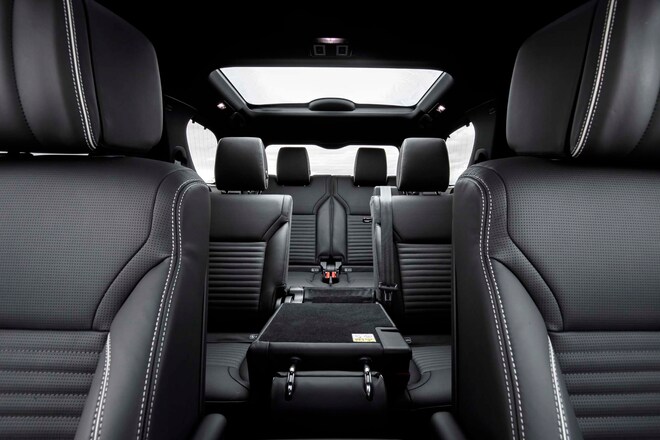
The Discovery is a true seven-passenger vehicle, as opposed to the Range Rover Sport, which is a 5+2. Adults can sit comfortably in the third-row theater seats in the Discovery, thanks to an added 1.5 inches of wheelbase. The second row travels 6.3 inches for easier access to the back, and there is 82.7 cubic inches of interior cargo space with all seats folded. Each seat folds independently into 21 seating configurations. Send them tumbling and folding via electric switches or even through an app on your smartphone. Fold the headrests from the touchscreen for better sightlines. And the inner tailgate is a perfect place to pregame.
It has a lot of cubbies, you can jam four computers into the center console, there’s a hidden compartment behind the HVAC controls, and it has nine USB and six 12-volt power outlets for all your various screens and devices.
Pricing starts at $50,985 for a base five-seat model, which is about $2,000 less than a Mercedes-Benz GLE or BMW X5 but slightly more than an Audi Q7 or a five-passenger Jeep Grand Cherokee.
As has been tradition for 70 years, Land Rover produces its vehicles in the English midlands town of Solihull. The first models destined for our shores are coming off the line now for sale this summer. Come hell or high water, get ready to start exploring.
| 2017 Land Rover Discovery | |
| BASE PRICE | $50,985 |
| VEHICLE LAYOUT | Front-engine, AWD, 7-pass, 4-door SUV |
| ENGINE | 3.0L/340-hp/332-lb-ft s’charged DOHC 24-valve V-6; 3.0L/254-hp/443-lb-ft/t’diesel DOHC 24-valve V-6 |
| TRANSMISSION | 8-speed automatic |
| CURB WEIGHT | 4,750-4,950 lb (mfr) |
| WHEELBASE | 115.0-115.1 in |
| LENGTH X WIDTH X HEIGHT | 195.7 x 78.7 x 73.5 in |
| 0-60 MPH | 6.9 -7.7 sec (mfr est) |
| EPA CITY/HWY/COMB FUEL ECON | 16-21/21-26/18-23 mpg |
| ON SALE IN U.S. | June 2017 |

